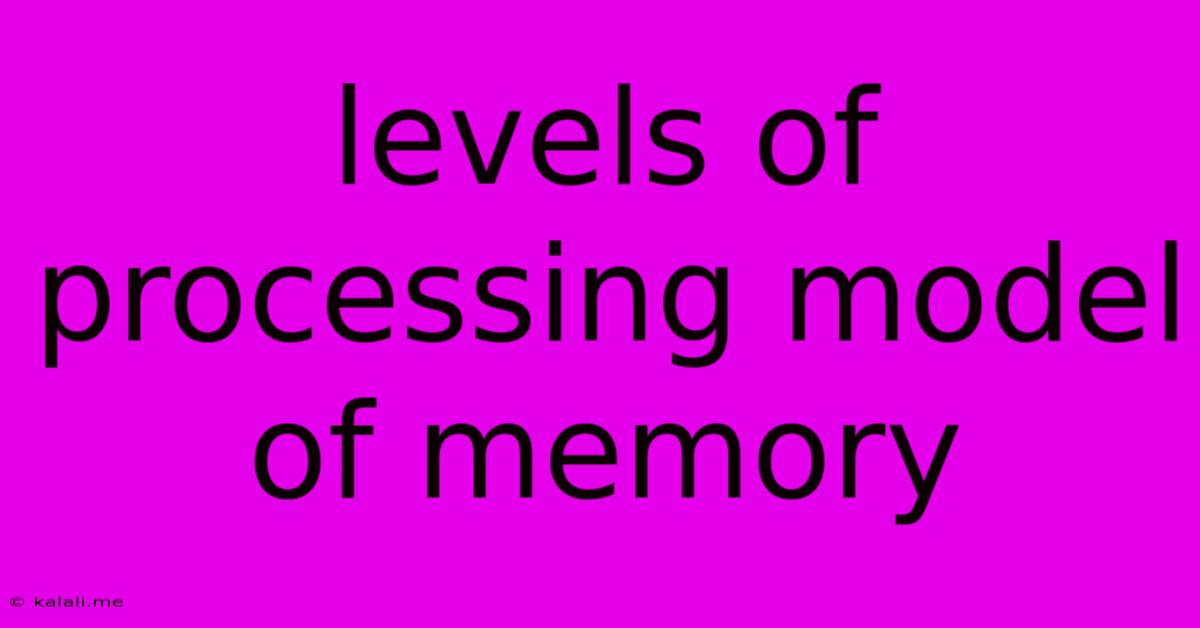Levels Of Processing Model Of Memory
Kalali
Jun 15, 2025 · 4 min read

Table of Contents
Levels of Processing Model of Memory: A Deep Dive
The Levels of Processing model, a prominent theory in cognitive psychology, explains how the depth of processing during encoding significantly influences the strength and duration of memory. Forget rote memorization; this model emphasizes the importance of meaning and elaboration in creating lasting memories. Understanding this model can revolutionize your study techniques and improve your overall memory retention.
This article will explore the different levels of processing, the supporting evidence, and the limitations of this influential theory. We'll also examine how you can apply the principles of deep processing to enhance your learning and recall.
The Core Principles: Shallow vs. Deep Processing
The Levels of Processing model proposes that memory is not a single, monolithic system but rather a continuum of processing depths. These levels range from shallow to deep, with deeper processing leading to more durable memories.
-
Shallow Processing: This involves encoding information superficially, focusing on its physical characteristics rather than its meaning. Examples include:
- Structural encoding: Concentrating on the physical structure of a word, like whether it's in uppercase or lowercase.
- Phonemic encoding: Focusing on the sound of a word.
-
Deep Processing: This entails a more meaningful and elaborate encoding process. It involves analyzing the information's semantic content, connecting it to prior knowledge, and creating meaningful associations. Examples include:
- Semantic encoding: Focusing on the meaning of a word and relating it to other concepts.
- Elaborative rehearsal: Connecting new information to existing knowledge through self-referencing, imagery, or creating stories.
Evidence Supporting the Levels of Processing Model
Numerous studies have supported the model's claims. Experiments often involve manipulating the depth of processing during encoding and then measuring subsequent recall or recognition performance. Studies consistently show that deeper processing leads to better memory performance compared to shallower processing. For instance, participants who are asked to process words semantically (e.g., by considering their meaning) tend to remember them better than participants who process the same words phonemically (e.g., by rhyming them).
Beyond Shallow and Deep: Different Types of Deep Processing
While the basic distinction between shallow and deep processing is crucial, it's important to note that deep processing itself can manifest in various ways. The effectiveness of deep processing depends on the specific strategies employed. Strategies like self-referencing (relating information to oneself), generating examples, and using imagery are all considered forms of deep processing that lead to superior memory outcomes. The more connections you forge between the new information and your existing knowledge network, the stronger the memory trace becomes.
Limitations and Criticisms of the Model
Despite its significant influence, the Levels of Processing model has faced some criticism. One major critique centers on the difficulty of independently defining and measuring "depth" of processing. The circularity problem arises because better recall is often used as evidence of deeper processing, creating a tautological relationship. In simpler terms, we can't definitively say processing is "deep" except by the fact that it leads to better recall.
Another limitation lies in its inability to fully explain the various factors that influence memory, such as the context of learning and the individual differences in learning styles and cognitive abilities. The model focuses primarily on the encoding stage and doesn't fully account for retrieval processes.
Applying the Model to Enhance Your Memory
Understanding the Levels of Processing model can significantly enhance your learning and memory retention. By consciously engaging in deep processing techniques, you can improve your recall of information. Here are some practical strategies:
- Elaborate on the material: Connect new information to what you already know. Ask yourself questions, generate examples, and explain concepts in your own words.
- Use imagery: Create vivid mental images to associate with the information you're trying to learn.
- Self-reference: Relate the material to your own life experiences and personal interests.
- Teach someone else: Explaining a concept to another person requires deep processing and reinforces your own understanding.
Conclusion: A Powerful Framework for Understanding Memory
The Levels of Processing model offers a valuable framework for understanding how the depth of encoding influences memory. Although it has limitations, the core principle of emphasizing meaning and elaboration during learning remains crucial for effective memory formation and retention. By actively engaging in deep processing strategies, you can significantly improve your ability to learn and remember information effectively. This understanding is key to improving academic performance, professional skill acquisition, and even everyday memory tasks.
Latest Posts
Latest Posts
-
What Is The Lcm Of 14 And 24
Jun 15, 2025
-
The San Andreas Fault Is An Example Of A
Jun 15, 2025
-
Is A Snake A Tertiary Consumer
Jun 15, 2025
-
How To Change The Sat Test Date
Jun 15, 2025
-
A Is The Brother Of B
Jun 15, 2025
Related Post
Thank you for visiting our website which covers about Levels Of Processing Model Of Memory . We hope the information provided has been useful to you. Feel free to contact us if you have any questions or need further assistance. See you next time and don't miss to bookmark.